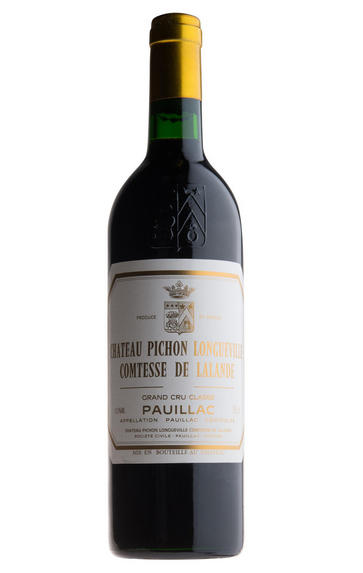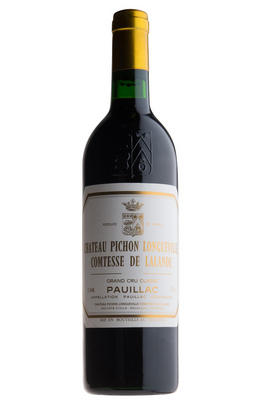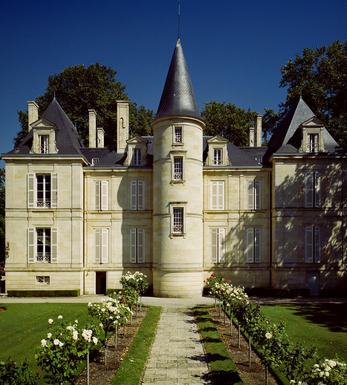
2012 Château Pichon Longueville Comtesse de Lalande, Pauillac, Bordeaux

Critics reviews
The 2012 Pichon-Lalande has a rather musky bouquet at first, with juniper and mint infusing the black fruit, not quite translating the essence of Pauillac and others, though still attractive. The palate is medium-bodied with supple tannins, fleshy and silky smooth. There is a veneer of high-quality oak here, quite plush on the finish yet, at the same time, nicely controlled. It has good potential, though I would like to see improvement aromatically. Tasted twice at Bordeaux Index’s Ten Year-On tasting and blind at the Southwold Ten-Year On tasting.
Drink 2022 - 2038
Neal Martin, Vinous.com (September 2022)
As it always is, the 2012 Pichon Lalande is a wine of pure and total seduction. The 2012 is neither the biggest nor most complex Pichon Lalande, but it is among the most pleasurable wine in this tasting, especially for near and medium-term drinking. Silky and medium in body, with lovely brightness, the 2012 has so much to offer.
Drink 2020 - 2042
Antonio Galloni, Vinous.com (October 2017)
Cabernet Sauvignon 59%, Merlot 28%, Cabernet Franc 8%, Petit Verdot, 5%.
Ruby red, with sweet fruit on the nose, both enticing and fragrant. Grilled cedar and smoked caramel; this is expertly judged in its use of oak, balanced but with a richness that runs right through the palate. Grip and flecks of cocoa bean, graphite, cracked pepper, and saline crackers make this welcoming and gourmet. Can begin drinking with a carafe, will not outlive the most concentrated vintages of Comtesse, but absolutely no rush to get going—one of the wines of the tasting. Today's director, Nicolas Glumineau, did the blend of this vintage but didn't follow the vines through the growing season.
Drink 2022 - 2042
Jane Anson, JaneAnson.com (March 2022)
Coming in at a lofty 13.2% natural alcohol, it offers up scents of black currants, white chocolate, berries, cedar and forest floor. Sweet tannin, a round opulence and a medium body result in a classic, supple-textured Pauillac that should drink well young and keep for 12-15 years. It is very much in keeping with what most readers would consider the “house style” of Pichon Lalande, even though they are moving toward more Cabernet Sauvignon and less Petit Verdot in the final blend.
Fifty per cent of the crop made it into the final blend of 2012 Pichon Lalande, which includes more and more Cabernet Sauvignon under the new ownership of the Roederer Champagne firm. The 2012 is a blend of 59% Cabernet Sauvignon, 28% Merlot, 8% Cabernet Franc and 5% Petit Verdot.
Drink 2013 - 2028
Robert M. Parker, Jr., Wine Advocate (April 2013)
Nicolas Glumineau's debut vintage.
Looks quite a bit more evolved than the Pichon Baron with a healthy garnet/ruby hue. Sweet biscuity nose. Very appealing already. Less concentrated than the Pichon Baron tasted alongside but very charming.
Drink 2020 - 2035
Jancis Robinson MW, JancisRobinson.com (March 2022)
Lovely creamy texture and supple fruit. It’s a delightful, relatively uncomplicated claret of medium weight and charm that’s probably now at its best.
Drink 2022 - 2030
Sebastian Payne MW, Decanter.com (March 2022)
The 2012 Pichon-Longueville Comtesse De Lalande is a beautiful, elegant wine in this slightly more challenging vintage (at least for the northern Médoc) and is well worth cellaring and drinking. A blend of 59% Cabernet Sauvignon, 28% Merlot, 8% Cabernet Franc and 5% Petit Verdot, it has classic Pauillac lead pencil notes as well as plenty of blackcurrants, tobacco leaf, and cedar. Medium-bodied, forward, and seamless on the palate, it shows the classic elegance of this estate, has ripe tannins, and is already impossible to resist. Enjoy this solid 2012 Pauillac over the coming 15-20 years.
Drink 2019 - 2034
Jeb Dunnuck, JebDunnuck.com (June 2019)
About this WINE

Château Pichon Comtesse
Château Pichon Comtesse is an estate in Pauillac on the Left Bank of Bordeaux. The estate was ranked a Second Growth in Bordeaux’s 1855 classification, and belongs to an unofficial group referred to as “Super Seconds”.
It is located in the southern part of the Pauillac appellation, just next to Château Latour and a short distance from the border with St Julien. The attractive château building here is visible from the D2 road as you approach Pauillac from the south, on the opposite side of the street from Château Pichon Baron. The two neighbours were once part of one larger estate, which was divided in two in 1850. From 1978 until the mid-2000s, Pichon Comtesse was managed by Madame May-Eliane de Lencquesaing, one of the most prominent women in Bordeaux history.
Today, the estate belongs to the Rouzaud family, owners of Champagne Louis Roederer. The estate, which currently has 80 hectares of vines, is managed by talented winemaker Nicolas Glumineau. Nicolas and his team also manage Château de Pez, a sibling estate further north in St Estèphe.

Pauillac
Pauillac is the aristocrat of the Médoc boasting boasting 75 percent of the region’s First Growths and with Grand Cru Classés representing 84 percent of Pauillac's production.
For a small town, surrounded by so many familiar and regal names, Pauillac imparts a slightly seedy impression. There are no grand hotels or restaurants – with the honourable exception of the establishments owned by Jean-Michel Cazes – rather a small port and yacht harbour, and a dominant petrochemical plant.
Yet outside the town, , there is arguably the greatest concentration of fabulous vineyards throughout all Bordeaux, including three of the five First Growths. Bordering St Estèphe to the north and St Julien to the south, Pauillac has fine, deep gravel soils with important iron and marl deposits, and a subtle, softly-rolling landscape, cut by a series of small streams running into the Gironde. The vineyards are located on two gravel-rich plateaux, one to the northwest of the town of Pauillac and the other to the south, with the vines reaching a greater depth than anywhere else in the Médoc.
Pauillac's first growths each have their own unique characteristics; Lafite Rothschild, tucked in the northern part of Pauillac on the St Estèphe border, produces Pauillac's most aromatically complex and subtly-flavoured wine. Mouton Rothschild's vineyards lie on a well-drained gravel ridge and - with its high percentage of Cabernet Sauvignon - can produce (in its best years) Pauillac's most decadently rich, fleshy and exotic wine.
Latour, arguably Bordeaux's most consistent First Growth, is located in southern Pauillac next to St Julien. Its soil is gravel-rich with superb drainage, and Latour's vines penetrate as far as five metres into the soil. It produces perhaps the most long-lived wines of the Médoc.
Recommended Châteaux
Ch. Lafite-Rothschild, Ch. Latour, Ch. Mouton-Rothschild, Ch. Pichon-Longueville Baron, Ch. Pichon Longueville Comtesse de Lalande, Ch. Lynch-Bages, Ch. Grand-Puy-Lacoste, Ch, Pontet-Canet, Les Forts de Latour, Ch. Haut-Batailley, Ch. Batailley, Ch. Haut-Bages Libéral.

Cabernet Sauvignon Blend
Cabernet Sauvignon lends itself particularly well in blends with Merlot. This is actually the archetypal Bordeaux blend, though in different proportions in the sub-regions and sometimes topped up with Cabernet Franc, Malbec, and Petit Verdot.
In the Médoc and Graves the percentage of Cabernet Sauvignon in the blend can range from 95% (Mouton-Rothschild) to as low as 40%. It is particularly suited to the dry, warm, free- draining, gravel-rich soils and is responsible for the redolent cassis characteristics as well as the depth of colour, tannic structure and pronounced acidity of Médoc wines. However 100% Cabernet Sauvignon wines can be slightly hollow-tasting in the middle palate and Merlot with its generous, fleshy fruit flavours acts as a perfect foil by filling in this cavity.
In St-Emilion and Pomerol, the blends are Merlot dominated as Cabernet Sauvignon can struggle to ripen there - when it is included, it adds structure and body to the wine. Sassicaia is the most famous Bordeaux blend in Italy and has spawned many imitations, whereby the blend is now firmly established in the New World and particularly in California and Australia.


Buying options
Add to wishlist
Description
Cabernet Sauvignon 59%, Merlot 28%, Cabernet Franc 8%, Petit Verdot, 5%.
Ruby red, with sweet fruit on the nose, both enticing and fragrant. Grilled cedar and smoked caramel; this is expertly judged in its use of oak, balanced but with a richness that runs right through the palate. Grip and flecks of cocoa bean, graphite, cracked pepper, and saline crackers make this welcoming and gourmet. Can begin drinking with a carafe, will not outlive the most concentrated vintages of Comtesse, but absolutely no rush to get going—one of the wines of the tasting. Today's director, Nicolas Glumineau, did the blend of this vintage but didn't follow the vines through the growing season.
Drink 2022 - 2042
Jane Anson, JaneAnson.com (March 2022)
wine at a glance
Delivery and quality guarantee